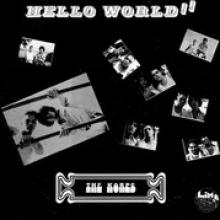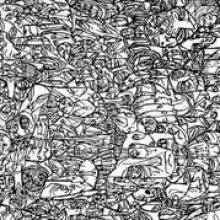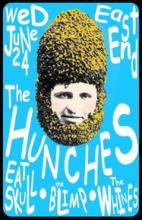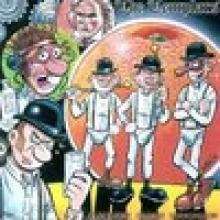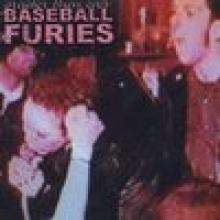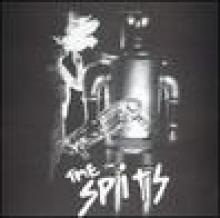The Pagans - When I Die (Video)
The Pagans - Not Now, No Way (Video)
Well, it's not '77 anymore, but the Pagans laid it down a few years back.
The Korps: A D.C. x Boston Mess
Skip Groff ran Limp Records out of his Yesterday and Today Records storefront, in Maryland. The imprint’s first pressings were from D.C. locals including the Slickee Boys and its cohort. A bit further along, though, Groff saw fit to issue a disc from a band that comprised members of the Afrika Corps. After relocating to Boston, though, Kenne Highland and Ken Kaiser shortened their band’s name to simply the Korps and set about recording an album.
While Highland and Kaiser always trucked in simple punk stuffs, the Korps included a pop sense not disconnected from the Ramones’ obsession with ‘60s girl groups. There’s nothing overt about the conncection between the NYC based group and these jokers, but reading into the compositions becomes relatively worth while considering the fact that almost everything represented on Hello World!, the band’s only full length, comes off like a well devised cover song.
The album is immediately related to its listeners as a singular work with Highland and Kaiser screaming “We are the only real people” into their collective mics. The song that follows is some where between Detroit’s hard rock stuff and LA’s nascent hardcore scene from about the same time. That being said, the sentiment is rather unique. Lyrically, the song connects Linda, Highland’s lady friend subsequent to moving to Boston, to the societal concept that most folks are fake. In 1978 the idea may have seemed novel even if the song as a whole arrives a bit dated.
And while that aforementioned song could be construed as something of a joke (maybe not), “Beat the Beets” is all laughs. Apart from the title itself, the song is kind of a diatribe against eating a balanced diet. Since the song winds up making mention of mashing potatoes, though, that Ramonesey tie to '60s dance tracks is present again.
With all of the tongue in cheek action, it’d be relatively easy to dismiss the musicality that each of these players possesses. That’s not to say that either is a master at any one instrument. Apart from the fact that the bass lines that were set down on each of the 16 tracks on the Gulcher reissue of Hello World!, there are actually some ripping guitar solos.
Yeah, that’s not what punk’s actually supposed to be about, but the adroit addition of a harmonica on “Have a Lark” points to the expansive interests that Highland and Kaiser possessed.
Regardless of all that, Hello World! didn’t really wind up becoming too much more than a footnote in east coast punk history. That doesn’t mean the slab isn’t a rewarding listen, but there’s a lotta other stuff to wade through.
Rudimentary Peni: A SciFi Themed Punk
That being said, there is some genuinely cool crazy-person art out there. Whether or not Nick Blinko, front man for Britain’s Rudimentary Peni, counts as one of these fringe peoples is up in the air. He’s well capable of regularly contributing to a band that’s maintained popularity over four decades, but has also done time in a few looney bins. That’s not meant as a criticism – and Blinko, assumedly, doesn’t walk around calling himself an outsider artist – but there needs to be some line drawn as to how people fit into the made up category, and folks should wonder if this guy does.
Regardless of how and where Blinko fits into the art world, though, his band has moved through punk’s past and retains a certain amount of deference even today – and with good reason.
First releasing a few singles during the early ‘80s and eventually working up a long player in ’83, the band continued on through 2008’s No More Pain.Over time the group’s gone through some musical shifts, but never completely detached itself from its noisome punk heritiage. Coming as a part of the second (or third) wave of British punk bands, Rudimentary Peni was lumped into a post-punk category and if not that then was considered anarcho-punk due to its ties to Crass and its recording imprint.
About six years into its recorded legacy, though, the band released an album in 1987 that serves as an homage to everyone’s favorite science fiction writer, H.P. Lovecraft. It might not be immediately apparent, but the lion’s share of Cacophony relates to the novelist and short story writer.
Most aurally recognizabe as kin to the writer is Cacophony’s second track “Horrors in the Museum” which begins as a simple poppy punk track, but soon devolves into whirring noises and feedback. There’re some monster sounds working around in the background, but more notable is the fact that the track is a bit more than three minutes long whereas the remained of the songs here are usually about a minute and some change. It’s a minor aspect of the work to point out, but it then seems that Blinko and Rudimentary Peni were interested in rendering Lovecraft in not just lyrical terms but in sound as well.
“Xenophobia,” much as the afforementioned track, trucks in a good deal of noise while attempting to display some odd distopian place and time where things won’t make complete sense. And then of course, there’s the Freaks reference.
Regardless of the intent of Rudimentary Peni and its album, the result is an interesting malange of punk, rock and (almost) gothy stuffs.
The Aughties: A Decade in Slabs of Punk (4/4)
These Detroit natives at some points forget that there’s supposed to be melodicism inherent in rock songs. Not always, but even when it seems as if Tyvek is faltering, its not. And that’s why the group has been able to consistently maintain its footing in the ever evolving underground music community. The fervor with which these guys play the wrong notes at the right times seems otherworldly. It is. But despite all that, “Frustration Rock” might be the best song released during the last decade. That’s no joke.
Ty Segall – Self Titled (Castle Face, 2008)
Even if the Bay’s Ty Segall worked on some disgusting teen show at some point, his music more than amply makes up for his cultural contributions prior to shifting gears from acting to garage based music. This first disc, released on John Dwyer’s imprint, finds Segall recording the entire thing alone. The results are far more convincing than latter works that couple the guitarist, drummer and singer with any number of unwitting foils. His Ramones cover here might even be in the same league as the original. Seriously.
Thee Oh Sees – Help! (In the Red Records, 2009)
Picking the best release from Thee Oh Sees is like picking a favorite child. You love them all – even their faults. So deferring to one is difficult. And while The Master's Bedroom Is Worth Spending a Night In includes highlights like “Block of Ice,” Help! retains the supremely adept song writing and marries it all to interesting instrumentation and a more fully integrated group dynamic. If nothing else, the flute jam that closes out a track mid set should convince anyone skeptical of the Bay’s current domination of garage related stuffs.
The Hunches – Exit Dreams (In the Red Records, 2009)
The fact that Portland’s the Hunches have been dissolved subsequent to its touring on the basis of this release shouldn’t deter folks from considering Exit Dreams a monumental slab of weirdo rock music. This effort might well be considered a departure for the group even as its noisiest tendencies are still reflected. But since the ensemble ostensibly knew that this was the end, there’s a bizarre urgency reflected in the work. The sense of impending doom isn’t what makes this a good release, but it no doubt contributed to the fact that the Hunches decided to include a wider pop palette on this disc.
Jay Reatard – Watch Me Fall (Matador Records, 2009)
Yeah, it seems like a cop to have included two albums from a single personage in this list. But you know what? The anti-social, downer songs that populate this newest full length from Memphis’ Jay Reatard are every bit as strong as its predecessor. Even with a more pop-centric approach to assembling songs, the bile that so defined his earlier work is still maintained. What’s here is as catchy as anything from Blood Visions, but in a more sunshiny form. Reatard won’t soon find himself at the top of the pops, but Watch Me Fall is certainly going to rally a bigger fan base around him.
The Aughties: A Decade in Slabs of Punk (3/4)
The North Bay of California isn’t well known for its punk stuff. More frequently, hippies work out some patchouli jams from that particular part of the country. Of course, wherever there’re hippies, there’re probably some punks sitting around decrying their nemesis’ existence. Right or wrong, that’s how it is. The Bodies, regardless of whether or not they were the folks sitting around lamenting the ‘60s thing, were able to maintain a small, but consistent label as well as releasing a string of singles, mini-LPs and full lengths that rivaled pretty much everyone else trucking in early ‘80s styled punk stuffs. Addicted to You isn’t that long, but in its aggression, topical subject matter and well constructed tunes, listeners should be able to find as much pleasure here as in bigger, more bloated bands.
The Black Lips – Let it Bloom (In the Red Records, 2005)
With all of the attention lavished on Atlanta’s Black Lips over its last two releases, it seems that folks forget how good they were prior to getting wrangled up with all of the hipster nonsense that Vice, its magazine and its label have come to represent. Of course, there’s nothing too drastically different going on during Let It Bloom and its ‘60s pop and garage inflected rock stuffs. That being said, the songs come off as a bit cleverer in addition to eschewing all of that self aware coolness that the Black Lips have become engulfed in. Earlier discs weren’t as good, nor were the latter ones. So, really, Let it Bloom is the only one that matters.
Easily the best African American, French influenced Oi! band ever. Ok, fine. They don’t have any competition. But whereas most skinhead rock stuff is horribly played and recorded, these guys are actually able to play a guitar solo and not have it come off as all watered down, high school shenanigans. Surely it’s odd that there’re still grown men that claim ties to the skinhead subculture, but with its overt Major Accident influence, listeners should be prepared for as many well crafted songs as references to getting even with those perceived to be enmeshed in some sort of transgressive behavior.
Jay Reatard – Blood Visions (In the Red Records, 2006)
It sometimes gets difficult to describe different ways that Jay Reatard is incredible. He’s probably tired of them all. But despite the voracious fandom that’s relatively recently been showered on him and his career, Blood Visions remains one of the most consistent and consistently catchy albums of the decade – punk or otherwise. Yeah, everyone has some lame story about how he’s wronged one person or another. And apart from the fact that at least some of those accounts have to be fabricated, who cares when this guy can rave up a punk track at once recalling the Adverts and the Urinals? Who else is working with that tandem of influence? No one.
The Aughties: A Decade in Slabs of Punk (2/4)
One of the smaller, but consistent labels that maintained a presence from the ‘90s through the early portions of the new millennium, the Big Neck roster was populated with garage fan(atics) and punk enthusiasts who didn’t see the difference between subgenres. That being said, not everything that the label released wound up being as cohesive as this Baseball Furies album. Comprising mostly punk stuffs, there’s a quick step swagger that should tell listeners that these guys weren’t strangers to classic hardcore ensembles from just prior to the genre’s codification. The Baseball Furies would eventually follow this disc up a few years on, but it just wasn’t the same. For a brief moment in time, the group was able to capture the abandon that punk was intended to have. Unfortunately, it was fleeting. Coping this disc, though, might send listeners back to their teen years.
The Piranhas - Erotic Grit Movies (In the Red Records, 2002)
The phrase ‘art punk’ might be one of the most hateful and insipid genre names ever conceived. Hopefully, there’s something artful about all music, so inserting that specific descriptor should be seen as pointless. But even as other Detroit natives, like the Clone Defects, have been tagged with the moniker, the Piranhas, on its first full length, were able to include the perfect amount of musicality into its noisome nonsense. There’re melodies present – and they’re even bountiful. That being said, there’s a pretty small segment of even the out music cognoscenti that aren’t gonna be able to palette this one. Erotic Grit Movies isn’t awful, it just wants you to think that it is.
The Exploding Hearts - Guitar Romantic (Dirtnap Records, 2003)
The tragedy that ended this band’s career is well documented and pervasively sad. It was all just an accident, but perhaps akin to the Big Bopper biting it for the punk crowd. Comparisons aside, the Exploding Hearts were able to so seamlessly blend punk and pop together that if the group had been around for a while longer, there’s really no reason that it wouldn’t have hit it big. Of course, the songs about eating pills and getting high and looking out into space wouldn’t have helped the Portland based group garner a proper record deal, but they probably wouldn’t have cared. So, seeing as this is the ensemble’s lone full length, it would seem that you need to go cop it right about….NOW.
The Spits – Self Titled (Nickel and Dime Records, 2003)
It’s difficult to figure out what Spits record people are referring to seeing as three of them are self titled. This disc – the one with a robot on the cover with either a red or black background depending upon what version you’ve got – is notable for its inclusion of “Tired and Lonely” amongst all of the other soon to be classics. And what the band might lack in musical proficiency, talent and manners it’s certainly made up for with good song writing and a rather unruly live show. And yes, one might find the Spits attired in mummy gear or even as robots. Bonus.
The Aughties: A Decade in Slabs of Punk (1/4)
Trying to round up the best of any one genre during a single year is almost counter intuitive. And working to distill an entire decade is almost just plain impossible. With there being so much stuff referred to as punk today, the endeavor actually becomes ridiculous. But nevertheless, what follows is a sort of short list of important, enjoyable and in some cases forgotten recordings from the last ten years that might not actually be the best, but are all worth a listen.
The inclusion of a number In the Red Records releases seems unfair. It might be, but the fact points to the imprints dogged tenacity at releasing high quality work. And while the label surely released a few clunkers, there’s more gold in there than in most label’s back catalogs
The first few Murder City Devils’ full lengths garnered the group enough of a following to eventually be affixed to the Sub Pop label. The Seattleites’ relationship with such a venerated outlet enabled the garagey group to tour with some proper support, even if the venues it frequented never grew in size. Regardless of that and the amazing songs cobbled together on this organ based ensemble’s disc, the release would be its last. Recently reforming for a west coast tour and an appearance at Chicago’s Riot Fest hasn’t hurt the group’s legacy. And maybe during next decade’s end round up, I’ll get to mention a reunion disc.
Geraldine – Pure Bastard Rock (Orange Records, 2001)
Being based out of Athens, Oh – a tiny college town renowned for its drunkenness and its love of herbs and spices – didn’t help Geraldine’s chances of making a proper name for themselves. During the first blossoming of the new millennium’s garage infatuation Geraldine cut a few singles and a full length for the Orange imprint. The album didn’t wind up making inroads into larger media markets (released today, that might not have been the case), but on every trip through Athens, groups that would eventually be greeted with success found Geraldine enticing enough of an opening act as to return again and again…
The Stitches – 12 Imaginary Inches (TKO Records, 2002)
The southern Californian’s that make up the Stitches weren’t going to be able to replicate the success that the 8x12 disc resulted in. That being said, a completely different approach to rock stuffs got cranked out for the groups TKO Records debut. Having moved to a bigger label may have informed some of the Stitches’ decisions – maybe not. But the new wave styled stuff that 12 Imaginary Inches was populated with referenced a punk past and pushed through it. There are always common elements in the Stitches work, but even the single that led up to the release of this disc couldn’t have prepared fans for what was here.
The Crowd: A SoCal Punk
One of the innumerable labels that grew out of the punk scene – in addition to the omni-venerable Bomp! – was Orange County’s Posh Boy Records. The clever moniker aside, the imprint was responsible for releasing everything from Social Distortion to ‘90s bands like the Offspring, who should rightly be considered the end result of tumult that the punk scene had sought to create.
Amongst the label’s laundry list of singles and full lengths were a few discs from a group called the Crowd. Posh Boy didn’t necessarily maintain a concerted and singular musical vision. Yeah, its releases were all punk related in one way or another, but with a scene as expansive as Southern California’s during the ‘70s, there’re endless strains of the genre pulling in various directions.
Over something like a twenty year period, the group would only release three full lengths. It’s first, though, would become a minor classic of sorts. There aren’t any avowed classics that wound up getting endlessly versioned, but A World Apart, even with its cheese ball cover remains an under appreciated entry into the LA punk scene.
Before the punk perfection gets examined, it’s worth noting that while most American bands shyed away from the reggae influence that the Clash displayed over there in the UK, the Crowd worked out some JA and rock hybrids. “Pressure Seeker” is all fey rock stuffs with hints of supplemental percussion and a reggae breakdown functioning as portions of each verse. The track’s not the most successful represented on A World Apart, but a curio that’s notable for its oddity if not its execution.
By contrast, “Desmond and Kathy” is pretty much a stone, punk classic. There’s enough power pop in there to tie the song to the Nerves or any of Peter Case’s endeavors. That being said, the Crowd intersperses its pop sensibilities with enough aggression to come off as something more than derivative and radio ready. The guitar solo might not work to endear the offering to punker purists, but with the group’s vocalist sporadically coming off like a tan Jello Biafra, it’s all just short of pop-punk perfection.
There a few other high water marks, but nothing really reaches back to “Desmond and Kathy.” Other places, as on “He,” the Crowd gets close, but not quite. And coming in at less than 30 minutes long, hunting the out of print disc down might be a bit anti climactic. That being said, for aficionados and collectors, A World Apart serves as not just a good disc, but a slab of historic punk. Just stay away from the reunion disc from the ‘90s.
